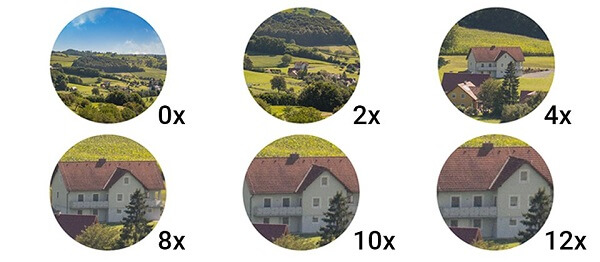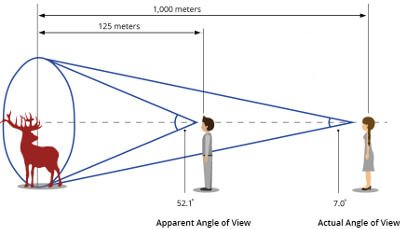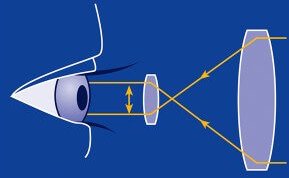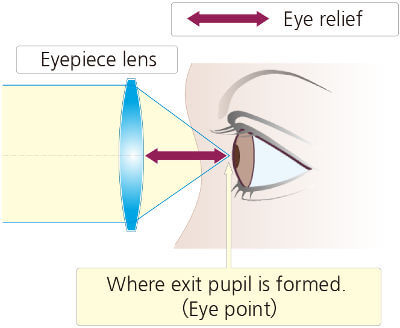Understanding what the numbers on binoculars mean will help you choose the perfect pair that best suits your needs.
When shopping for an optical enhancement device, you will find a wide price range of similar looking devices, and sometimes you feel overwhelmed by most of the information about these devices.
Just like all other technologies, the field of binoculars has its own confusing terminologies. Ever wondered what the numbers 8×25 or 10-50×50 mean?
Generally, binoculars are specified by a set of two numbers like 10×30, 8×54, and 10×54. The first number tells you the strength of the magnifications (i.e., how many times the subject is increased in size). In contrast, the second number is the objective lens size, which is usually measured in millimeters.
How large the objective lens is will determine the amount of light the binocular will take in for effective viewing. Other specs include the Angle of View, Exit Pupil Number, Eye Relief Number, Field of View, and Close Focus Distance.
Binoculars Magnification.
A set of 2 numbers often identifies binoculars, and these numbers show the magnification strength and the lens diameter.
The first number represents the magnifications. Magnification tells you how many times closer, the subject will appear as compared to the naked eye.
For example, the 10×30, 10×50, and 10×42 binoculars have a magnification of 10.
The magnification power of 10 means that the subject will appear 10 times closer than it would to a naked eye. If you view a bird that stands 300 yards away through the 10x binoculars, it will appear to you as though it were 30 yards away (300 divided by 10).
When you see 10-30×50 or 10-50×50, this means the binos are zoom and can be magnified from 10 to 30 and from 10 to 50, respectively. It is easy to assume that 10×30 means 10 is multiplied by 30, but that is very wrong.
In fact, the ‘X’ represents the magnification, and for the 10×30 binocular, the ‘X’ means 10 times the magnification.
Objective lens size (Aperture).
The objective lens is the lens at the front (i.e., pointing towards the subject) and not the one you look through. The second number represents the size of the objective lens diameter measured in millimeters.
The objective lens size determines how much light the binocular can take in for effective viewing. 10×30 binoculars have a magnification of 10, and the objective lenses are 30mm in diameter.
The higher the number, the wider the objective lens, and the more light the binocular will obtain, making the image brighter. The lens size is significant as it affects the light gathering ability. However, binoculars having a smaller objective lens like 8×25 and 10X30 are more compact.
The Angle of View.
To explain the meaning of Angle of View, it is best to start with the field of view, which is how wide an area is visual in the binocular’s image.
The Angle of View is the Angle (in degrees) between the right and the left extremes of the field of view from the center of the objective lenses.
The angular field of view can be converted to a linear field simply by multiplying the angular field by 52.5.
Field of View.
The field of view is the width of the area you see through your binocular. For instance, if two birds are standing 1000-yards away from you, one to your right and the other one to your left, and the distance between these two birds is 360 feet, then we can say your field of view is 360ft at 1000 yards as you look through the binoculars.
Generally, the higher the magnification, the smaller the field of view, whereas low powered binoculars give you a larger field of view. If you want to get a wide view, it’s preferable to use a low powered binocular, and this is because higher magnification power results in a smaller field-of-view.
A wide field-of-view is best to identify moving objects such as birds. The field of view is also expressed in degrees.
Exit Pupil Number.
The exit pupil is also an important factor determining how bright an object is viewed in low light conditions, and a higher exit pupil number means brighter images. The exit pupil number is the diameter of the beam of light coming from the eyepiece.
In other words, it is the diameter of the beam of light coming from the eyepieces of the binocular to your eyes. The calculation is based on the magnification power and the objective lens size. The actual exit pupil number is the calculation from dividing the objective lens size by the magnification of the binocular.
For example, 8×54 binoculars have an exit pupil of 6.75mm, and 10×50 binoculars would have an exit pupil of 5mm. We recommend that one have a binocular with an exit pupil number that equals your own pupils. This is because in poor light conditions, our eyes pupil open to about 6 to 7mm wide, thereby allowing more light to pass to the pupil.
Whereas, in bright conditions, our eyes pupils can contract to 2-4mm in size, in such conditions, the extra light coming from a binocular with an exit pupil number of 5-7mm isn’t needed.
Close Focus Distance.
Just like the field of view, the close focus distance also determines how much of the world one will see through the binoculars. It is the minimum distance an object should be to be within the focus range.
The close focus distance of a binocular generally depends on the optical design and, to some extent, on an individual’s eye vision.
Close Focus Distance between 8-10 feet is ideal for many outdoor activities, but their close focus distance is around 20 to 25 feet for general-purpose binoculars.
Eye Relief Number.

Eye relief is the length in millimeters between your eyes and each eyepiece, while the whole field-of-view afforded by your binoculars is visible. Extended eye-relief minimizes eye strain. This increases comfort when using the binoculars by allowing you to hold the binoculars farther away from your face, which is ideal for spectacle wearers.
Eye-relief is an important factor to consider when buying any optical enhancement device. When viewing an object using a binocular with an eye-relief below 10mm, one will only see the image’s center.
Most binoculars have an eye-relief of 8-13mm., and a few have a 16-18mm eye-relief. Generally, the longer the eyeglass, the better and the friendlier a binocular is to eyeglass wearers.
Conclusion.
Understanding binoculars specs and terminologies such as exit pupil number, objective lens diameter, magnification power, the field of view, and eye relief number will help you choose a pair of binoculars that would best suit your needs.
Binoculars come in various sizes defined by the size of the objective lens for various outdoor activities. Full-size binoculars are best for use on boats and wildlife viewing. These binoculars usually perform better even in low light conditions. The 10×42 and 10×50 are examples of full-size binoculars.
The mid-size binoculars are best for sport and wildlife viewing. They are moderate in size and have an average light transmission ability.
The 10×30 and 7×35 are examples of mid-size binoculars. The last group is the compact binoculars, and they are best for daytime usage. They are the smallest and the lightest binoculars, and the 8×25 and 10×25 are examples of compact binoculars.
Read Also:
- How to Use Binoculars Properly
- How To Focus Binoculars In The Correct Way
- Adjust your binoculars in the correct way
- What not to do with your Binoculars
- Difference Between Telescope and Binoculars
- How Does Binoculars Magnification Work
Leave a Reply